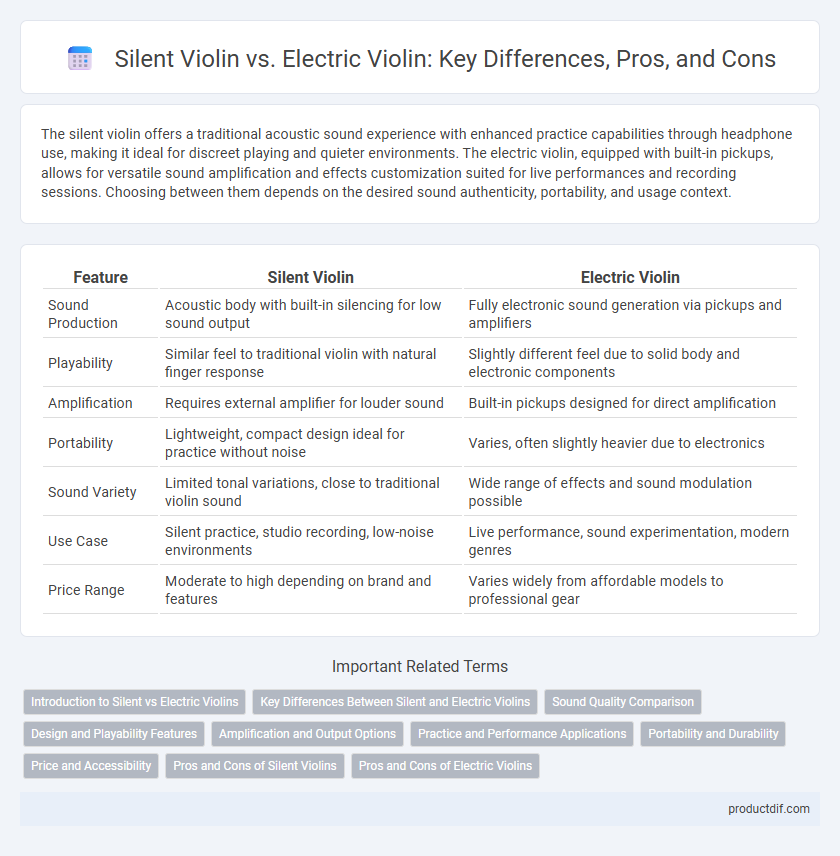The silent violin offers a traditional acoustic sound experience with enhanced practice capabilities through headphone use, making it ideal for discreet playing and quieter environments. The electric violin, equipped with built-in pickups, allows for versatile sound amplification and effects customization suited for live performances and recording sessions. Choosing between them depends on the desired sound authenticity, portability, and usage context.
Table of Comparison
| Feature | Silent Violin | Electric Violin |
|---|---|---|
| Sound Production | Acoustic body with built-in silencing for low sound output | Fully electronic sound generation via pickups and amplifiers |
| Playability | Similar feel to traditional violin with natural finger response | Slightly different feel due to solid body and electronic components |
| Amplification | Requires external amplifier for louder sound | Built-in pickups designed for direct amplification |
| Portability | Lightweight, compact design ideal for practice without noise | Varies, often slightly heavier due to electronics |
| Sound Variety | Limited tonal variations, close to traditional violin sound | Wide range of effects and sound modulation possible |
| Use Case | Silent practice, studio recording, low-noise environments | Live performance, sound experimentation, modern genres |
| Price Range | Moderate to high depending on brand and features | Varies widely from affordable models to professional gear |
Introduction to Silent vs Electric Violins
Silent violins and electric violins both offer amplified sound options but serve different purposes; silent violins focus on reduced acoustic sound for practice with headphones, while electric violins are designed for live performance with built-in pickups and tone control. Silent violins typically maintain the traditional wooden body to preserve natural feel, whereas electric violins often feature solid or unique body materials to enhance durability and sound effects. Understanding these differences helps musicians choose the right instrument based on practice needs, sound quality, and performance settings.
Key Differences Between Silent and Electric Violins
Silent violins prioritize acoustic sound quality with minimal external noise, featuring built-in dampers to reduce sound output, making them ideal for private practice. Electric violins rely on electronic pickups to amplify sound, offering extensive tonal customization and effects through external amplifiers or pedals for live performance settings. The main difference lies in their design purpose: silent violins emphasize quiet practice without sound projection, while electric violins focus on amplified sound and versatility for stage use.
Sound Quality Comparison
Silent violins produce a rich, natural tone closely resembling traditional acoustic violins due to their hollow body design and high-quality pickups. Electric violins offer greater sound versatility, enabling users to modify tone and effects extensively through amplification and digital processing. Sound quality preference depends on whether authenticity or customizable audio features are prioritized by the musician.
Design and Playability Features
Silent violins feature a solid body design that reduces acoustic sound for practice without disturbing others, while electric violins often include pickups and preamps to amplify sound for performances. Silent violins typically prioritize lightweight build and portability, making them ideal for quiet practice sessions. Electric violins emphasize diverse tonal control and effects integration, enhancing playability for stage use and genre versatility.
Amplification and Output Options
Silent violins feature built-in piezo pickups that deliver a natural acoustic tone through headphones or external amplifiers, ideal for practice without disturbing others. Electric violins often include active pickups and onboard preamps, offering a wider range of output options such as direct line-outs, XLR connections, and MIDI compatibility for studio and stage performances. Both instruments provide versatile amplification solutions, but electric violins typically support more professional and diverse sound processing setups.
Practice and Performance Applications
Silent violins offer musicians the advantage of near-silent practice with high-quality headphone output, making them ideal for quiet environments and late-night rehearsals without disturbing others. Electric violins provide amplified sound and various effects, enhancing live performance capabilities and allowing seamless integration with sound systems and pedals in different stage settings. Both instruments support versatile practice routines, but electric violins excel in dynamic performance scenarios due to their customizable sound profiles.
Portability and Durability
Silent violins are designed with lightweight, compact frames that enhance portability, making them ideal for musicians who travel frequently. Electric violins often feature robust, solid bodies and reinforced components, providing superior durability to withstand rigorous use and handling. Both instruments offer practical advantages, but silent violins prioritize ease of transport while electric violins emphasize long-term resilience.
Price and Accessibility
Silent violins typically range from $300 to $1,500, making them more affordable and accessible for beginners and casual players. Electric violins, on the other hand, often start around $500 and can exceed $3,000, reflecting higher costs due to advanced electronics and build quality. Availability of silent violins is generally broader in music stores, while electric violins may require specialty shops or online retailers for purchase.
Pros and Cons of Silent Violins
Silent violins offer the benefit of near-silent practice, allowing musicians to play without disturbing others, which is ideal for apartments or late-night sessions. They usually feature a solid body with minimal resonance, resulting in less authentic acoustic sound compared to electric violins but often include built-in headphone jacks for private listening. However, silent violins lack amplified sound output on their own and typically require external amplification or effects pedals for performance settings, limiting their versatility compared to fully electric violins.
Pros and Cons of Electric Violins
Electric violins offer enhanced sound amplification and recording capabilities, making them ideal for live performances and studio sessions. Their versatility includes built-in effects and the ability to connect to various audio devices, though they require external amplification compared to acoustic violins. The main drawbacks are a less traditional sound quality and higher dependence on electronic components, which may affect maintenance and reliability.
Silent violin vs Electric violin Infographic

 productdif.com
productdif.com